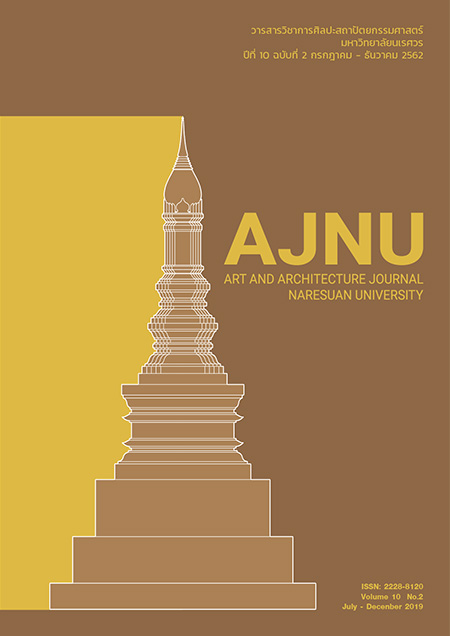The Study of the Characteristics of Post-Earthquake Housing Modification and Repair: The Case Study of Ban Sai Khao Sub-district, Phan District, Chiang Rai Province
Main Article Content
Abstract
The objective of this study is to investigate and collect the physical characteristics of the residences after the earthquake disaster in Chiang Rai province. By focusing on the modifying and activities affected residences due to the co-learning process of local technicians and related agencies. The 6.3 magnitude earthquake in Chiang Rai on May 5, 2014, had adversely impact and was centered at Mae Lao District, Chiang Rai. There were many co-organization for restoration houses and sharing knowledge to local. It leads to a vital significant to create a conceptual framework for the rehabilitation of housing in order to responding the earthquake disaster that is likely to happen in the future. This study uses a field study to collect data from Ban Sai Khao Sub-district, Phan District, Chiang Rai Province. The data was collected from local houses with a structured interview. The results of this study showed that for affected houses under a limited budget, some people chose to modify their house with local technicians. House modification was based on level of damage as follows:
1) structural damage such as broken pillars and beams were repaired by local technicians through drilling to insert steels, founding pillars or removing and moving existing position for nearby reconstruction, 2) damage to floor, wall, and roof materials were repaired by homeowners with local technicians by filling and plastering or replacing new materials such as roofing sheets, 3) damage to the entire building with irreparable condition was solved by maintaining the existing physical characteristics and materials but adopting safer materials and structures.
Article Details
References
ระยะเร่งด่วน 3 เดือนแห่งการบูรณาการความร่วมมือเพื่อการรับมือกับแผ่นดินไหว จังหวัดเชียงราย. เชียงใหม่ :
หจก.วนิดาการพิมพ์.
ฐิตยา สารฤทธิ์. (2561). Self-Extensional Space in Relocated Housing After 2004 Indean Ocean Tsunami: Case
Study Namkem Community, PhangNga, Thailand. Journal of Disaster Research, 13(1), 168-176.
เป็นหนึ่ง วานิชชัย. (2557). สัมภาษณ์พิเศษ รศ.ดร.เป็นหนึ่ง วานิชชัย ประธานคณะอนุกรรมการ สาขาผลกระทบจาก
แผ่นดินไหว และแรงลม วสท. วิศวกรรมสาร. 67(2), 85-90.
สาวิตรี ศรีสวัสดิ์ และระวิวรรณ โอฬารรัตน์มณี. (2559). การถอดบทเรียนภูมิปัญญาการปรับตัวของเรือนพื้นถิ่นไทใหญ่บ้านแม่
สาม-แลบจังหวัดแม่ฮ่องสอน.
วารสารวิชาการประจำคณะสถาปัตกรรมศาสตร์ มหาวิทยาลัยศิลปากร. 30(2016),
33-53.
สำนักเฝ้าระวังแผ่นดินไหว กรมอุตุนิยมวิทยา. (2559). รายงานการเกิดแผนดินไหวบริเวณประเทศไทย และ
พื้นที่ใกล้เคียง เดือนเมษายน พ.ศ. 2559. สืบค้นเมื่อ 22 พฤศจิกายน 2561, จากhttp://www.earthquake.tmd.go.th
เอกชัย กิตติวรากูล ; ประดิษฐ์ เจียรกุลประเสริฐ ; ปิยะวัฒน์ วุฒิชัยกิจเจริญ. (ตุลาคม 2557).
การประเมินความเสียหายและการ
ซ่อมแซมบ้านที่ได้รับผลกระทบจากเหตุการณ์แผ่นดินไหว จังหวัดเชียงราย กรณีศึกษา ดงลานโมเดล. การประชุมวิชาการคอนกรีตประจำปี ครั้งที่ 10. สืบค้นเมื่อ 1 สิงหาคม 2561, จาก https://www.researchgate.net
เอกวิทย์ ณ ถลาง และคณะ. (2546). ภูมิปัญญาท้องถิ่นกับการจัดการความรู้. กรุงเทพฯ : สำนักพิมพ์อมรินทร์.
อมร พิมานมาศ. (2557). วิเคราะห์ 5 สาเหตุหลัก โครงสร้างเสียหายจาก เหตุแผ่นดินไหวเชียงราย. วิศวกรรมสาร, 67(3), 47-49.
อมรา สุนทรธาดา. (2557). การฟื้นตัวของชาวเชียงรายหลังแผ่นดินไหวครั้งรุนแรงที่สุดในไทย. ประชากรและการพัฒนา,34(6), 6-7.

